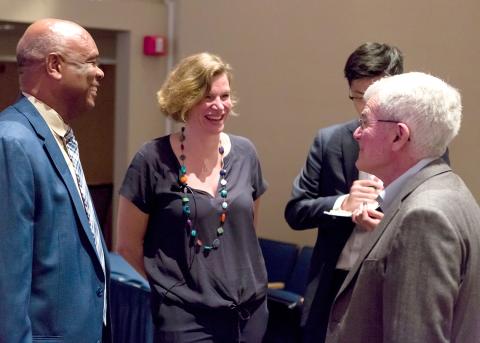Making ‘Bureaucratic’ Sexy
Seminar Speaker Seeks Rewrite of Innovation Script

Photo: Daniel Soñé
Did you know that government innovation helped develop smartphone technology? It’s true. In fact, NIH, along with the National Science Foundation and the Department of Defense, invested early in research on liquid crystal display, which was incorporated into the first-generation iPhone that debuted in 2001. And that’s just one of more than a dozen components—microprocessors, lithium-ion batteries and DRAM cache, for example—of today’s cell phones that can trace its origins in some way back to federal ingenuity.
It’s arguably one of the coolest—and nowadays most essential—inventions so far in the 21st century and government’s crucial role in its development is hardly ever acknowledged. That may be because of perception: Most folks view the private sector as this wildly creative, cutting-edge space while they see government solely as a safe, risk-averse, rescue zone.
Time to flip the script, says Dr. Mariana Mazzucato, professor in the economics of innovation and public value at University College London (UCL), founder-director of the UCL Institute for Innovation and Public Purpose and recent NIH guest.
For the global economy’s sake, she suggested, thought leaders here and elsewhere in the public sector should all help change the narrative.
“I want to make the word ‘bureaucratic’ a really sexy word,” she said, cracking a smile but speaking in earnest. “So when something is described as bureaucratic, I want people to go, ‘Oh how cool!’”
It’s not in her official bio, but the economist could easily also practice linguistics. She visited NIH recently in Masur Auditorium, hoping to provoke an interactive discussion about the role of the government in modern-day capitalism.
Her talk—“The State and Innovation—From Fixing Markets to Co-Creating,” the final lecture in last season’s Deputy Director for Management Seminar Series—challenged the audience to widen its vocabulary and tell more complete stories about who leads innovation.

Photo: Daniel Soñé
“Storytellers rule the world,” Mazzucato said, recalling philosopher Plato’s declaration. “The history of innovation in modern-day capitalism has a lot of bureaucracy behind it. We know so little about it because of the myths that continue to exist…The state—this decentralized network of different types of public institutions—has been the foundation of so much of the competitiveness across different sectors, from energy to information technology to health.”
When you think of what government agencies do in the marketplace, terms like de-risk, enable, incentivize and facilitate often come to mind, Mazzucato said. But do such words capture the full gamut of the breakthrough research, creative vibe and dynamic environments found at federal institutions such as NIH, DARPA and the Department of Energy?
Public funding, Mazzucato noted, has been vital in such game-changing innovations as the internet, Global Positioning System and touch-screen display. About $5 billion in government funding helped engineer-entrepreneur Elon Musk bring the widely successful Tesla electric car concept to market, she pointed out.
Indeed, lots of federal entities constantly pioneer in a wide range of fields and historically have led innovation on a number of fronts, she said. They just rarely get the credit for it in public discourse.

Photo: Daniel Soñé
“This notion that the state is there to fix failures is not really wrong,” she explained. “It’s just really limiting.”
Take “spending” versus “investing,” she said. Civil servants are most likely to be called spenders, not investors, the name reserved for risk-takers perceived as hip, cool and attractive.
“The state has been an investor of first resort, not just a lender of last resort,” Mazzucato said.
Noting that in one book about iPhone creator Steve Jobs and Apple, there is virtually no mention of the huge public sector contribution to the success of its products, Mazzucato explained, “It’s not to dismiss the [crucial design elements of the iPhone] and the talent inside Apple. It’s to dismiss this very narrow, skewed way that we tell that story.”
After the most recent worldwide financial crises, the idea reemerged that economic growth has not just a rate but a direction, Mazzucato said. “All of us are now rethinking that direction towards smart growth, which translates to better innovation; sustainable growth, which is more green; and inclusive growth,” which tries to spread gains more equally among diverse peoples.
“The role of a public actor,” she continued, “should be not only to throw money into the system but also to catalyze a transformation of a system,” as in the green sustainability market. “To do that you often need to upset the status quo, to get the private sector to behave differently from how it is behaving.”

Photo: Daniel Soñé
Mazzucato said forethinking governments are considering how best to use the investment tools they have—grants, equity, loans, procurement policy—to influence the direction of private sector enterprises and “make receiving such funds conditional on achieving public objectives.”
Public sector enterprises such as NIH, she said, are legitimate “co-creators and co-shapers of the market,” who “bring together different voices at the table to define the market in the first place.” That powerful leadership can galvanize cross-sectoral, cross-action, cross-disciplinary, multiple competing solutions.
“Redefine the landscape,” Mazzucato urged. “Don’t just fix the existing landscape.”
She offered a 4-part “people’s prescription” for re-imagining health innovation to deliver public value:
- Use a mission-oriented approach to improve health outcomes
- De-link innovation funding from high prices
- Achieve public return through conditionality
- Explore alternative ownership and corporate governance models beyond shareholder value.
Continuing the misperception that the private sector is the most innovative part of public-private partnerships and should therefore set prices and define the market is a bad deal, Mazzucato concluded.
“That doesn’t mean we shouldn’t partner,” she said. “Of course we must partner. We can only tackle any of these problems together, but how you do it matters.”
Following her talk and a brief Q&A session, Mazzucato chatted informally and signed copies of her books at a meet & greet event sponsored by FAES in its bookstore.
You can read the full people’s prescription online at https://www.ucl.ac.uk/bartlett/public-purpose/publications/2018/oct/peoples-prescription.
